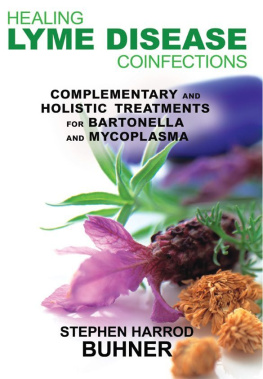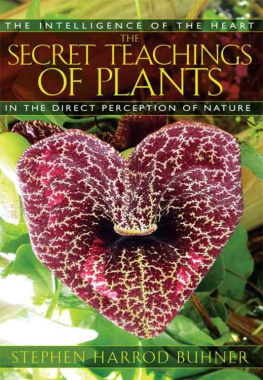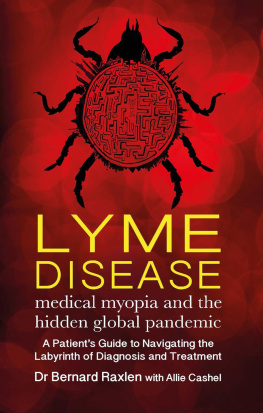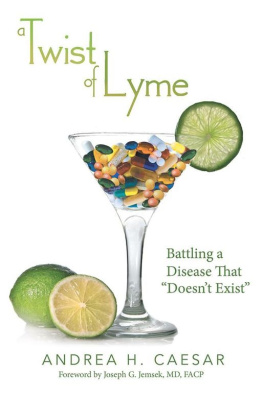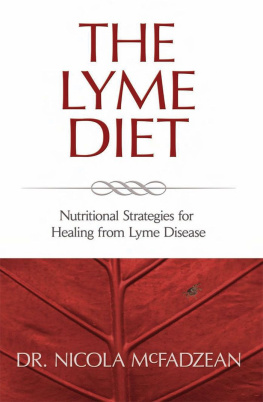For Julie McIntyre,
whose caring for and dedication to her patients
is a constant inspiration to me.
And for everyone who has struggled with
either of these diseases
there is hope,
dont give up.
HEALING
LYME DISEASE
COINFECTIONS

Bacteria outnumber us, outthink us, cooperate better than we do, and inhabit a far wider range of ecological niches. Without them we would be dead, yet many of them are lethal. For the past one hundred years we have waged war on them, and we are losing. Stephen Harrod Buhner is not afraid. He is paving a path into a future where we use simple tools to nourish cooperative health. If you or anyone you love has ever had an infection, you need this book. At times technical, at others dryly lyrical, it is sure to become a gleaming guidepost to many who have resigned themselves to a lifetime of distress and a trusted reference for health professionals wishing to assist those with resistant and chronic infections.
SUSUN S. WEED, AUTHOR OFHEALING WISE AND
MENOPAUSAL YEARS THE WISE WOMAN WAY
Packed with information never before presented, Healing Lyme Disease Coinfections is a not-to-be-missed treasure on the topic of Lyme disease. While exploring numerous new therapeutic interventions, Buhners pure intent and deep wisdom unfold before the reader, while his humorous style lightens the journey. This book is a masterpiece that provides its readers with life-changing information and is poised to become the reference book for the ages.
SCOTT FORSGREN, EDITOR AND FOUNDER OF
BETTERHEALTHGUY.COM
Well rooted in the scientific literature and benefitting from a deeply cultivated knowledge of herbalism, this exceptionally well-written book is an empowering resource for those suffering from Lyme disease coinfections and an essential reference for their clinicians.
LAURIE REGAN, PH.D., N.D., DEAN OF CLASSICAL CHINESE
MEDICINE AT NATIONAL COLLEGE OF NATURAL MEDICINE
AND COHOST OF TRUE NATURE RADIO
Contents
How to use this Book and Who it is for
This book is meant for two groups of people: 1) those who are suffering from a difficult-to-treat bartonella or mycoplasma infection, and 2) clinicians who themselves treat people with bartonella or mycoplasma.
IF YOU HAVE BARTONELLA OR MYCOPLASMA
This book is designed to help you understand the disease itself and as well to understand some of the approaches that can be used to treat the disease and the symptoms it causes.
Please understand that some of the book is fairly technical. That is for the clinicians (or for you if you want to delve that deeply into it). You can skip the really technical bits if you want. They are not necessary to understand in order to treat either of these conditions effectively. In general, I think you will find the overview chapters on both bartonellas and mycoplasmas useful. The deeper technical look at the cytokine cascade and the minutiae of what the organisms do in the body are not really necessary if you just want a good overview of the bacteria.
The book also explores just how widespread these kinds of infections are. And, as usual, the real figures are very different than what the Centers for Disease Control (CDC) indicateby a factor of anywhere from 100 to 1,000. Both bartonellas and mycoplasmas are very common and there are many millions of people in the United States, between one-tenth and one-third of the population, who are asymptomatically infected. Treatment is often difficult and many physicians dont understand how to treat or diagnose these bacteria very well, so this book also examines which antibiotics (and tests) research has found useful (and which ones are not).
The book also contains an extensive look at the natural protocols that are effective for each of the diseases. Please note: these protocols are designed to be able to be used along with antibiotics. I dont think you necessarily have to give up either pharmaceuticals or natural medicines to find health. However, if you have tried antibiotics and they have failed to help you, the protocols in this book can be used all by themselves to treat both bartonellas and mycoplasmas.
Also, a note: the herbs and supplements in this book are not the only ones in the world that will help. Please use the protocols outlined herein only as a starting place, a guideline. Add anything that you feel will help you and delete anything that you feel is not useful. Bacteria, when they enter a human body, find a unique ecosystem in that particular person. Thus the disease is always slightly different in every person. That means that a pharmaceutical or herb that works for one person may not work or work as well for another. There is no one-size-fits-all treatment for these particular organisms.
As well: if you have a very healthy immune system, you will probably need to use smaller doses; if your immune system is severely depleted, you may need to use larger doses. If you are very sensitive to outside substances, as some people with Lyme, bartonella, and mycoplasma can be, then you might need to use very tiny doses, that is, from one to five drops of tincture at a time. (This is true for about 1 percent of the people with these infections.)
Please be conscious of how you respond to the medicines you take inside you. If something disagrees with you, if you feel something is not right in how you are responding to a medicine,stop taking it. Remember: you will always know yourself better than any outside physician.
IF YOU ARE A CLINICIAN
I have gone into a lot of depth on both bartonella and mycoplasma organisms so that you can begin to understand just how complex their actions in the body are. It is my hope that Western herbal medicine can begin to emerge as a highly sophisticated form of healing. To that end I have introduced the idea of thinking about the synergies that exist between coinfections as well as the concept of examining the kind of cytokine cascades bacteria create during infection. Each stealth pathogen decreases the activity of certain parts of the human immune system and activates others. So while some parts of the immune system become less functional, others become overactive. The overactivity comes from the initiation of unique cytokine cascades. Each stealth pathogen creates a different kind, that is, they stimulate certain kinds of inflammation in the body, using the bodys own immune response for their own ends. This is important to understand when designing any kind of elegant, interventive treatment strategy. If you know what is happening in the body, you dont have to guess what to doyou know what to do.
And while I dont go into it in any depth in this book, the idea of the complex synergies that exist between herbal medicines is crucial, as is an understanding of herbal synergists. These concepts are developed in detail in the revised and expanded second edition of my book Herbal Antibiotics (Storey Publishing, 2012). If you wish to look deeper into plant synergists and herbal synergies, I think you will find that book useful. As well, time and space limitations made the inclusion of in-depth monographs on many of these herbs impossible to include in this volume. I have done in-depth monographs on many of these herbs elsewhere; if you would like to see them they can be found in three other books:

